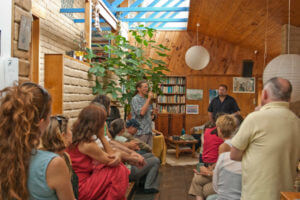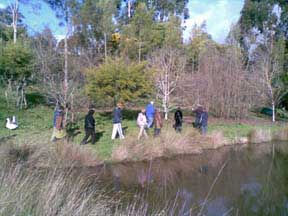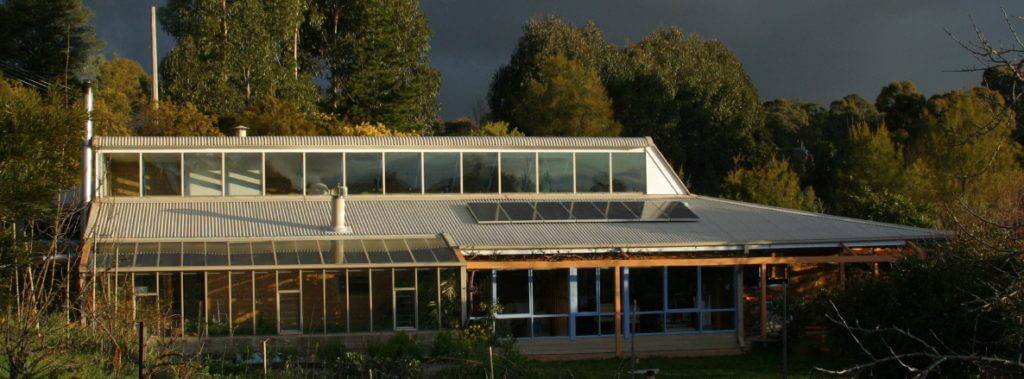As an environmental policy social scientist, I have long been interested in how the world feeds itself and the people who propose new ways of doing this.
Accordingly I became acquainted with “permaculture” in my university days in Melbourne, Australia in the mid-1980s. My interest was initially piqued by a documentary that put a positive spin on this alternative food production and lifestyle movement that was spawned by two of my fellow Australians, Bill Mollison and David Holmgren, in the late 1970s.
On his website David Holmgren describes permaculture as:
Consciously designed landscapes which mimic the patterns and relationships found in nature, while yielding an abundance of food, fibre and energy for provision of local needs. People, their buildings and the ways in which they organise themselves are central to permaculture. Thus the permaculture vision of permanent or sustainable agriculture has evolved to one of permanent or sustainable culture.
As the above definition implies, permacultursists avoid monoculture and advocate biodiversity. All permaculturists are highly critical of conventional agriculture, which they believe is unsustainable and environmentally damaging, and eschew genetically manipulated plants and synthetic pesticides and fertilizers. Accordingly permaculture is often considered part of the organic food movement.
Is permaculture grounded in science?
Permaculturists also tend to favor medium and low technologies that allow for greater self-reliance over high technologies that are usually more costly and cannot be built and repaired on site; for example a manual treadle pump might be preferred over an electric pump to move water from a dam  to crops. For all of these reasons, permaculture is viewed favorably by many green groups like Greenpeace.
to crops. For all of these reasons, permaculture is viewed favorably by many green groups like Greenpeace.
Permaculture’s relationship with agroecology depends on what you think that hotly contested term means. The University of Wyoming started the first land grant university agroecology course in the United States some 20 years ago and it is firmly in the science camp. According to Andrew Kniss, associate professor, weed biology and ecology at Wyoming, agroecology is a science that looks at agriculture as a complete ecosystem that must be sustainable and does not make an arbitrary distinction between natural and synthetic; hence in theory it should have no problem with using all the tools in the biotechnology toolkit, including GMOs and synthetic pesticides and fertilizers if they contribute to sustainable production.
Scientific agroecology has little or no interest in the largely permaculture movement; however the agroecology movement has been ‘claimed’ by certain more radical organic and permacutlure advocates, who reject certain aspects of modern technologically-focused farming, including the use of biotechnology. Kniss, among others, believes that many in the agroecology movement misrepresent the science.
In the English speaking world (Anglosphere) the term agroecology is also used by some interdisciplinary university courses and an associated social movement that is highly critical of conventional agricultural practices, the role of large agricultural corporations (Big Ag) and biotechnology; it is difficult to analytically separate it from the permaculture movement. Although it has much earlier antecedents, modern agroecology in the Anglosphere only emerged as a significant and continuous social movement and academic discipline after permaculture came to prominence.
Take note of these words from Michel Pimbert, director, Centre for Agroecology and Food Security, Coventry University in The Conversation for example:
Current farming methods rely too much on expensive chemicals such as fertilizer and pesticides; agroecology combines the best of ecological science and farmers’ knowledge to develop more sustainable food and farming.
Pimbert goes on to call for the “re-localizing” of food, free non-proprietary seeds, small farms and trade protection for local food producers in a “de-growth” economy facing increased energy and resource constraints. All of these talking points were anticipated in early permaculture discourse, and are perhaps most comprehensively covered in David Holmgren’s 2002 book Permaculture; Principles and Pathways Beyond Sustainability.
In spite of the affinities between the two, alternative agroecology researchers have done little research on permaculture, according to a paper by Rafter Ferguson and Sarah Lovell published in Agronomy and Sustainable Development in 2013. To date permaculture exists almost entirely outside the world of science, although Ferguson and Lovell believe this is changing. Nonetheless, in spite of the lack of research, Ferguson and Lovell believe permaculture is a key agroecological movement that will play an important role in pivoting world food production from what they call ‘industrial agriculture’ to agroecology.
Ferguson, a University of Illinois agroecology academic, strongly identifies as a permaculture activist.
The aspirations associated with permaculture obviously resonated with many people because not long after Mollison and Holmgren coined the term, permaculture training courses and permaculture associations sprung up in much of the world, in both developed and developing countries. According to one website more than one million people have now done one of the short courses on permaculture design in over 140 countries. I found these numbers impossible to verify and they may be an exaggeration but a quick search with Google is enough to show that permaculture has a significant presence in an impressive number of countries. While permaculture may not be mainstream, it is now respectable enough for the University of Massachusetts Amherst Permaculture Initiative to have been named White House Campus Champions of Change in 2012.
Touring the founding permaculture farm
A few years ago I took an early retirement, left the city of Melbourne and bought a farm. I recently noted that David Holmgren’s permaculture property, Melliodora, was just a 50 minute drive away and that Holmgren offers guided tours, so I booked one for early December to see for myself what permaculture looks like in practice. Melliodora is 2 1/2 acres situated on the edge of a pretty tourist town famed for its mineral water springs, Hepburn Springs. On arrival I found a mudbrick house, several goats and a few geese, a couple of dams, some trees including fruit trees and a vegetable plot that looked much like my own.
So what are my impressions after a five hour Melliodora farm tour with David Holmgren? My first impression is that David and his partner Su Dennett are pleasant, hard-working and sincere people. I cannot fault them for the lifestyle they have chosen. I also don’t doubt that they have chosen a great environment in which to raise children. But it is also readily apparent that such a lifestyle could only ever suit that idiosyncratic niche of people who are prepared to work long hours on endless farm chores and bottling, pickling and otherwise preserving produce during the brief boom periods.
David and Su make money from their permaculture tours and courses and they get enormous  assistance from unpaid workers through the WWOOF (Willing Workers On Organic Farms) scheme. This is a luxury not available to most “permies”, so it is little wonder that most permaculture fans have simply applied the permaculture label to their small suburban backyard plot of organic vegetables and fruit trees but otherwise live fairly conventional lives.
assistance from unpaid workers through the WWOOF (Willing Workers On Organic Farms) scheme. This is a luxury not available to most “permies”, so it is little wonder that most permaculture fans have simply applied the permaculture label to their small suburban backyard plot of organic vegetables and fruit trees but otherwise live fairly conventional lives.
David was upfront about how permaculture in practice means learning on the job and many failures as well as successes. In spite of the knowledge advantage David has over rookies, mistakes in soil amendment mean his strawberries and beans grow poorly. Some vegetable seed has failed to germinate and others have produced meagre crops. Another problem is cockatoos stripping the nuts and fruits off trees and

ripping holes in the nets that are meant to protect them. David envisages a possum invasion as his trees mature.
Noticeably absent were the multi-layered productive plantings, whereby a vine might grow up a tree beside a bush with some ground cover underneath that is often mentioned in permaculture literature.
Meanwhile the dam walls are undermined by yabbies (native freshwater lobsters), foxes eat the mature poultry, ravens eat all the chicks and the goats must be constantly tethered or controlled with expensive electrical fencing to stop them eating everything in sight. Farming sure ain’t easy!
 I noticed the jetty for the main dam had caved in. A picture on Melliodora promotional material shows a fishing net being cast from the jetty and David boasts about his fish and yabby harvests, yet as most rural people know, catching yabbies is more about entertainment than sustenance because they only have small edible tails and the red fin fish stocked by David are mostly small and bony and water birds like white faced heron eat much of the bounty. Interestingly, the dams were completely devoid of vegetation. Gone were the water chestnut producing rushes featured in the Melliodora ebook I purchased. One of the dams has an electrical water pump rather than a low technology alternative like a treadle pump which is an interesting choice given what David has written about the importance of self-reliance and our impending descent into a world of scarce energy.
I noticed the jetty for the main dam had caved in. A picture on Melliodora promotional material shows a fishing net being cast from the jetty and David boasts about his fish and yabby harvests, yet as most rural people know, catching yabbies is more about entertainment than sustenance because they only have small edible tails and the red fin fish stocked by David are mostly small and bony and water birds like white faced heron eat much of the bounty. Interestingly, the dams were completely devoid of vegetation. Gone were the water chestnut producing rushes featured in the Melliodora ebook I purchased. One of the dams has an electrical water pump rather than a low technology alternative like a treadle pump which is an interesting choice given what David has written about the importance of self-reliance and our impending descent into a world of scarce energy.
Does Meliodora fulfill its ecological ambitions?
Another point worth mentioning is that Melliodora “robs” nutrient from the surrounding land as it collects water from a large semi-urban watershed that includes a golf course that appears to be a well fertilized. Nutrient is also robbed by the goats who spend their days eating the dense thickets of invasive Blackberry and Hawthorn along the creek that runs along the back of Melliodora. In this way, Melliodora is far from self-sustaining.
Worryingly from a conservationist perspective, David and Su have vigorously lobbied the local shire to ensure the creek isn’t cleared of invasive exotic plants and restored with native vegetation: clearly they think free goat tucker is a much higher priority! Melliodora also consumes large amounts of town water to keep the garden productive during dry times, even though it has water tanks and two dams. Melliodora is one hundred per cent reliant on the electricity grid, without a solar panel or wind turbine to be seen, although the house design ensures minimal heating and cooling costs.

At the end of the day it is clear that Melliodora does little to justify the urban romanticist and alternative agroecology academic’s dream about permaculture offering an easy, self-sufficient and sustainable rural or semi-rural life that works in harmony with the rhythms of nature. Without access to unpaid labor, David and Su would be bonded to the land and forced to work like medieval serfs. Without abundant offsite inputs like firewood, electricity, water and fertiliser, David and Su would be living much like medieval serfs!
Also, living in romantic harmony with nature is simply not possible when nature throws at you droughts and floods and dozens of species of animal that will inevitably eat much of your produce unless you have the money, time and inclination to turn your property into something reminiscent of a supermax prison in lockdown.
David and Su make no bones about using drastic measures to wage war on unwanted animals, including killing blackbirds with carefully concealed rat traps.
It is readily apparent that because permaculture is very labor intensive, it cannot possibly compete with highly efficient and capital intensive conventional agriculture unless it exploits voluntary labor or pays workers’ wages that consign them and their families to extreme poverty.
Based on what I saw, it is no surprise that permaculture in the industrial world is mostly a hobby engaged in by urban romantics and a small lifestyle movement for rural diehards but, some 40 years after its birth, it plays no appreciable role in feeding the industrial world. Outside the industrial world, and in spite of some boastful claims made by permaculture fans that haven’t been subject to proper scrutiny, permaculture still looks very much like a small fish in a large ocean.
Maybe permaculture can make a small but useful contribution to world food production in the future, but if it is to do so it will first need to embrace the scientific method and use all of the tools available in the biotech toolkit.
Steve Munn lives in retirement with his wife on a central Victorian farm in Australia that they are turning into a native forest rich with bird and animal life. He has a Bachelor of Social Science in Environmental Policy from the Royal Melbourne Institute of Technology and has spent roughly half his life living in both city and rural locations, working in everything from shearing sheds to high rise office blocks.































